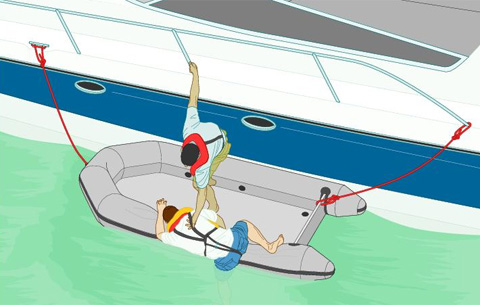
Man Overboard recovery - Five minute briefing
Top tips for successful recovery.
Getting back to a person in the water is the easy bit; the work really starts when it comes to getting them out.
A person in the water loses strength quickly and also increases in weight as their clothing becomes waterlogged. Often the crews’ only option is to use an aid to help recover the casualty. Time is of the essence and if a recovery system is not already in place there is a good chance that the person in the water will deteriorate rapidly.
So here are a few top tips for quick and safe man overboard recovery.
Assistance
Whilst you may be able to get back to a person, it is quite possible that you may fail to get them out of the water. By promptly sending a MAYDAY and DSC Distress alert the rescue services can come to your assistance to help recover the person overboard and give any necessary medical help.
Retrieval
A horizontal lift, or a lift that put the legs slightly higher than the head, helps keeps an even blood pressure and reduces the chance of a heart attack when the person is lifted from the water. However, if this is impossible to achieve or the person is drowning, get them out any way you can then sort out any other problems afterwards.
Rescuer safety
A rescuer leaning out over the guardrail or swim platform can put themselves on danger and the rescue in jeopardy. During the rescue ensure they are harnessed or tied to the boat to prevent them going over the side.
Attach a line
A lifting strop with attached line will make hoisting the casualty easier. Alternatively, lasso a line around the casualty and tie them to the boat.
Purchase systems
A block and tackle or purchase system will hoist someone from the water. A 4:1 system is usually the minimum purchase that could be used but consideration should be given to find somewhere high and strong enough to attach it. A line might be led to the rope drum of the windlass (if fitted) or a powered winch to give assistance.
Swim platform
A swim platform is an ideal place to retrieve a casualty if conditions permit. If you drag an unconscious person up swim platform it may not be possible to get them further onboard so tie them to the platform.
Liferaft
Launching the liferaft offers a floating platform close to the sea into which the casualty can enter or a crew can assist the casualty aboard. Ensure the raft is tied to the boat before launching. The casualty can be warmed and treated in the raft or lifted back aboard the boat.

Ladder
Ladders allow the casualty to assist in their rescue by utilising their stronger leg muscles alongside their arms and legs.
A ladder or scrambling net should ideally extend 2 foot (600mm) below the yachts waterline so the casualty can place their foot on the bottom rung.
There are many ways to make a ladder or foothold. A line from the aft cleat draped in the water to an amidships cleat or windlass can provide a step.
Dinghy
If the dinghy is accessible and weather conditions allow, it offers a platform for either the person in the water to help themselves back aboard or for a crew to assist the casualty. Tubes on an inflatable dinghy can be partially deflated to help retrieval.
Davit
Davits and cranes may be capable of lifting a person clear of the water but their use will require practise from crew beforehand.
Purchased aids
There are many retrieval aids on the market but the big question on a motorboat is still how to get them out, consider what hoists, block and tackles, winches etc. you have or need to effect recovery
Test it
How you retrieve someone from the sea will depend on whether they are conscious, what retrieval aids the boat carries, the crew strength and sea conditions. So make sure you practice or have a plan.
To gauge how good your retrieval method is lie down on the pontoon and see if your crew can start to hoist you.
Written on behalf of the RYA by Simon Jinks
Contact UsArticle Published: November 14, 2012 10:22
Article Updated: May 20, 2013 14:15